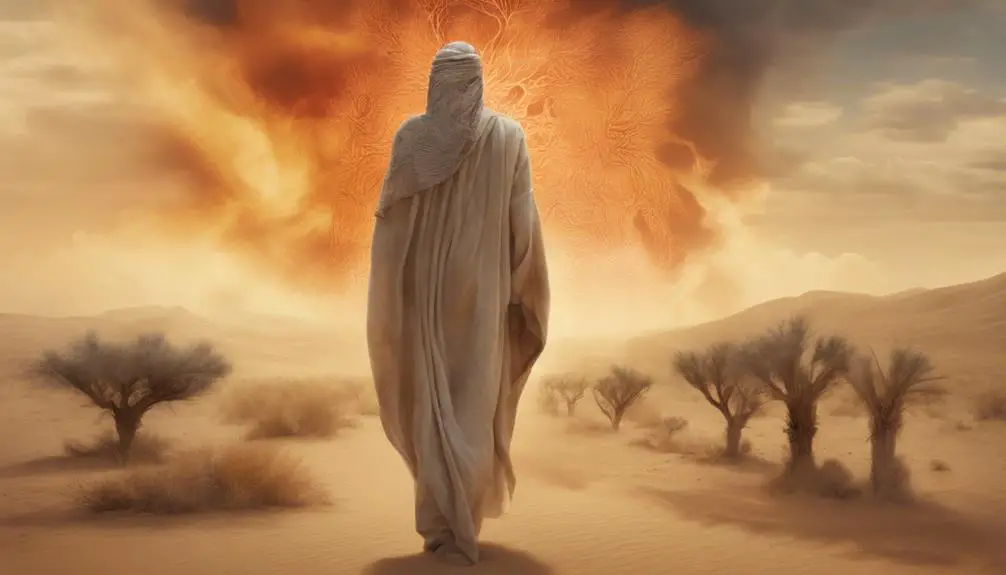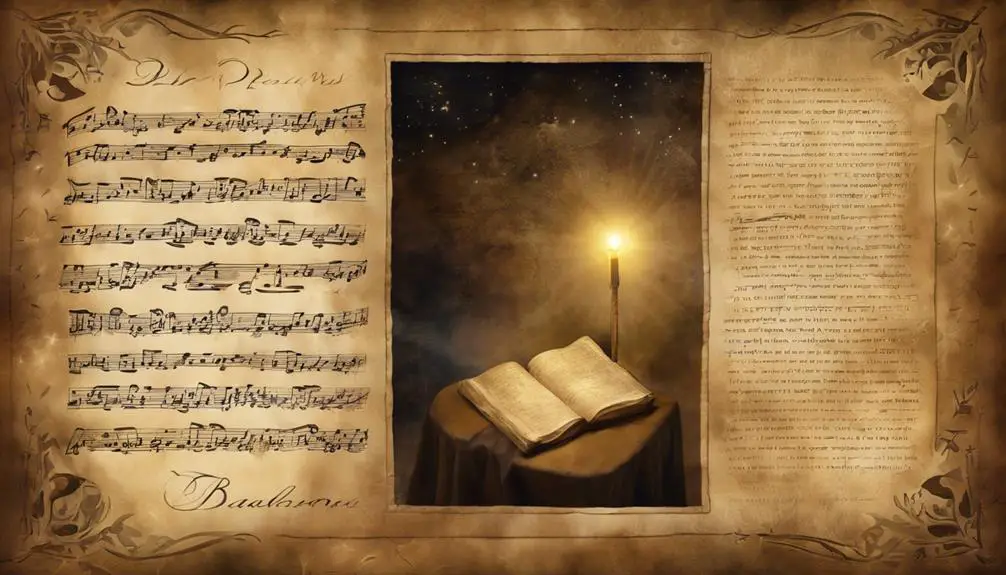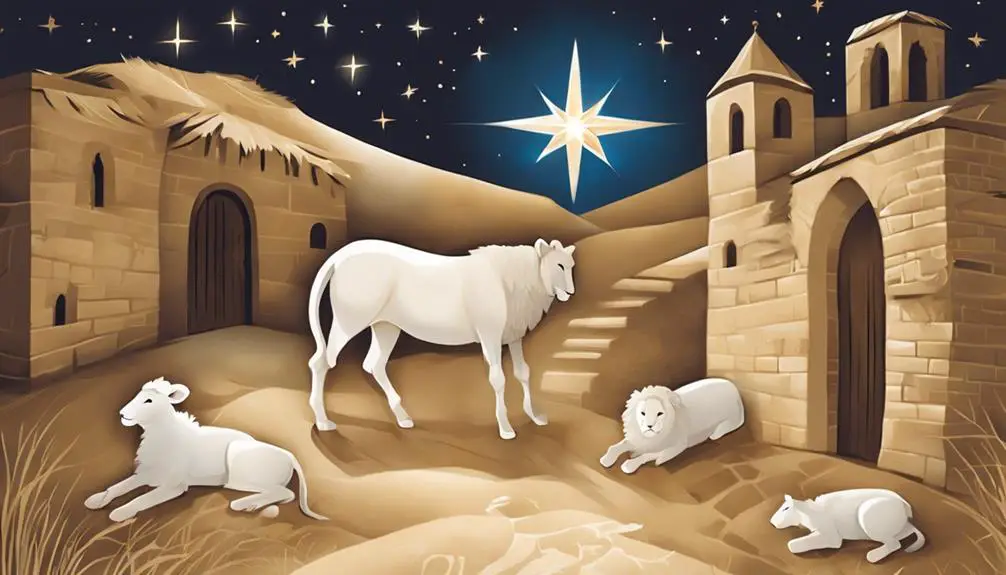Trace the hidden presence of Jesus in the Old Testament, unlocking secrets that illuminate His story and purpose.

Jesus in the Old Testament Bible Study
Imagine you're embarking on a treasure hunt, where ancient maps whisper secrets of hidden gems. Your quest isn't for gold or jewels, but for discovering Jesus within the tapestry of the Old Testament.
As you embark on this journey, you'll uncover prophecies, narratives, and symbols that poignantly prefigure the Messiah. Each element, from creation stories to the Psalms, serves as a breadcrumb leading to a deeper understanding of Jesus' role and presence throughout biblical history.
Now, you stand at the threshold of an intriguing exploration, poised to uncover how these ancient texts weave together a story that resonates to this day.
Key Takeaways
- Old Testament prophecies and symbols intricately prefigure Jesus' birth, mission, and divine nature.
- Jesus is portrayed as actively involved in creation and as wisdom personified, emphasizing His pre-existence and eternal authority.
- Theophanies and figures like Melchizedek symbolize Jesus' direct involvement and foreshadow His earthly ministry and sacrifice.
- Psalms and prophetic scriptures anticipate Jesus' roles as Messiah, suffering servant, and eternal king, underscoring His fulfillment of divine promises.
Prophecies Foretelling Jesus

Throughout the Old Testament, numerous prophecies meticulously foreshadow the coming of Jesus, offering profound insights into His life, mission, and the pivotal role He was destined to play in humanity's salvation.
The virgin birth, a cornerstone prophecy, is articulated in Isaiah 7:14, where it's declared, 'Therefore the Lord himself will give you a sign: The virgin will conceive and give birth to a son, and will call him Immanuel.' This prophecy not only highlights the miraculous nature of Jesus' birth but also underscores His divine mission as God with us, blending the supernatural with the tangible in a manner that was unprecedented.
Equally significant is the prophecy concerning Jesus' Davidic lineage, which is crucial for understanding His kingship and messianic identity. The promise made to David in 2 Samuel 7:12-13, that his throne would be established forever, finds its fulfillment in Jesus, who's often referred to as the Son of David. This lineage not only situates Jesus within a specific historical and cultural context but also ties Him to the covenant promises made to David, emphasizing His role as the eternal king who establishes God's kingdom on earth.
These prophecies, among others, weave a complex tapestry that meticulously prepares for the advent of Jesus, grounding His divinity and messianic mission in deep-rooted biblical traditions.
Jesus in Creation Narratives

Delving into the creation narratives, it's evident that Jesus' presence and influence are subtly interwoven from the very outset of the biblical text, offering a foundational perspective on His divine nature and eternal purpose. Through a scholarly lens, you can discern the imprints of His Divine Word and Cosmic Sovereignty etched into the fabric of creation. This multifaceted role is illuminated by:
- The identification of Jesus as the Divine Word through which all things were made, underscoring His active participation and authority in creation. 'In the beginning was the Word, and the Word was with God, and the Word was God' (John 1:1) parallels the Genesis account, revealing a pre-existent Christ who embodies the voice of God in creation.
- The depiction of Jesus as sustaining all things by His powerful word, which speaks to His ongoing involvement and Cosmic Sovereignty over the universe.
- The portrayal of Jesus in Proverbs 8 as wisdom personified, involved in creation, offering insight into His integral role in the order and design of the cosmos.
These elements collectively paint a picture of Jesus not merely as a figure in the New Testament but as an eternal entity with intrinsic involvement in the universe from its inception.
Theophanies: God's Appearances

In biblical scripture, theophanies serve as pivotal moments where God manifests directly to humans, revealing His divine nature and intentions in a tangible form. These appearances, ranging from angel encounters to divine dreams, aren't merely historical anecdotes but are rich with theological significance, showcasing God's active participation in human history.
When examining angel encounters, it's crucial to differentiate between mere messengers and manifestations of God Himself. For instance, the Angel of the Lord in the Old Testament often speaks as God, performs miracles, and accepts worship, actions that ordinary angels would redirect towards God. These encounters suggest a visible, yet mysterious presence of God, engaging directly with humanity.
Divine dreams offer another layer of theophanic activity. They aren't simple figments of imagination but structured, divine communications that provide guidance, prophecy, and revelation. Through dreams, God transcends the ordinary limitations of time and space, reaching out to individuals with messages that carry forward His divine plan.
These theophanies reflect God's desire to connect with His creation intimately, providing a foretaste of the ultimate revelation in Jesus Christ. They serve as foundational events that underscore the continuity of God's salvific work from the Old Testament to the New.
Symbolic Representations of Jesus

Many symbols in the Old Testament serve as profound representations of Jesus, foreshadowing His coming and illuminating His role in salvation history. These symbols, deeply embedded in the narrative and prophetic texts, offer a rich tapestry of insights that prefigure Christ's mission and identity.
- The Melchizedek Figure: This enigmatic priest-king of Salem represents a type of Christ in his role as the eternal priest. Melchizedek's offering of bread and wine prefigures the Last Supper, symbolizing Jesus' sacrifice and eternal priesthood. The absence of genealogical details about Melchizedek in Scripture accentuates the idea of an eternal priesthood, mirroring Jesus' unending priesthood as described in the New Testament.
- Wisdom Personified: In Proverbs and other wisdom literature, Wisdom is often personified and depicted as being with God at the beginning of creation. This portrayal of Wisdom as a co-creator and guide parallels the Logos concept in the New Testament, where Jesus is described as the Word made flesh, who was with God in the beginning and through whom all things were made.
- The Sacrificial System: The elaborate sacrificial system outlined in Leviticus points towards Jesus' ultimate sacrifice on the cross. The unblemished lambs and other offerings required for atonement prefigure Christ, the Lamb of God, who takes away the sin of the world through His perfect sacrifice.
These symbolic representations enrich our understanding of Jesus' mission and identity, connecting the Old Testament with the New in a profound and cohesive narrative.
Jesus in the Psalms

ARTICLE TITLE: Old Testament Bible Study on Jesus
PREVIOUS SUBTOPIC: 'Symbolic Representations of Jesus'
CURRENT SUBTOPIC: 'Jesus in the Psalms'
The Psalms, serving as a spiritual tapestry, intricately weave prophetic glimpses of Jesus' ministry, suffering, and kingship, inviting you to explore the depths of their Christological significance. As you delve into the Psalms, you'll notice how they function both as Royal psalms and as part of Wisdom literature, offering a multifaceted portrayal of the Messiah.
Psalm Reference |
Christological Significance |
|---|---|
Psalm 2 |
Foresees Jesus as the anointed king, defying Earth's rulers in establishing God's kingdom. |
Psalm 22 |
Vividly predicts Jesus' sufferings and crucifixion, echoing his forsaken cry on the cross. |
Psalm 72 |
Portrays a reign of justice and righteousness, mirroring Jesus' earthly and heavenly rule. |
Psalm 110 |
Announces the Messiah as a priest forever, in the order of Melchizedek, highlighting Jesus' eternal priesthood. |
These passages, among others, enrich your understanding of Jesus' multifaceted role as revealed in the Psalms. Through this scholarly exploration, you're encouraged to perceive the Psalms not just as ancient songs, but as a complex layer of Wisdom literature and Royal psalms that prefigure the Messiah's life and mission.
Messianic Expectations Fulfilled

Having explored the prophetic dimensions of Jesus in the Psalms, we now turn our attention to how these messianic expectations are concretely fulfilled in the New Testament narratives. The fulfillment isn't just a matter of happenstance but a carefully orchestrated revelation that spans centuries, connecting dots from ancient prophecies to their realization. Here, we delve into the specifics, examining the depth of this fulfillment through various lenses:
- Genealogical evidence underscores Jesus' legitimate claim to the throne of David, a crucial aspect of messianic prophecy. Matthew and Luke meticulously trace Jesus' lineage, ensuring that He fits the Old Testament criteria for the Messiah. This isn't merely a genealogical curiosity but a foundational proof of Jesus' messianic identity, fulfilling the promises made to David.
- Covenant significance of Jesus' actions and teachings reveals Him as the mediator of a new covenant, fulfilling Jeremiah's prophecy of a new covenant not like the one made with their ancestors. This new covenant, sealed by Jesus' sacrifice, fulfills and transcends the old, establishing a direct, unbreakable relationship between God and humanity.
- The fulfillment of specific prophecies, such as the virgin birth, the betrayal for thirty pieces of silver, and the crucifixion alongside criminals, further cement Jesus' identity as the foretold Messiah. Each of these fulfillments not only aligns with the messianic expectations set forth in the Old Testament but also showcases the intricate precision of God's plan for redemption.
Frequently Asked Questions
How Do Various Jewish Traditions Interpret the Passages Commonly Associated With Jesus in the Old Testament?
You're diving into how Jewish traditions view Old Testament passages often linked to Jesus, focusing on Messianic Prophecies and Rabbinic Interpretations. These traditions don't see these texts as foretelling Jesus' life but rather interpret them through historical or metaphorical lenses, often emphasizing a future Jewish Messiah or spiritual concepts.
This approach underscores a rich tapestry of analytical and scholarly perspectives, offering a detailed exploration of biblical interpretation within Judaism.
Are There Any Notable Differences in How Eastern Orthodox, Roman Catholic, and Protestant Denominations Understand the Presence of Jesus in the Old Testament?
Yes, you'll find notable differences among Eastern Orthodox, Roman Catholic, and Protestant denominations in understanding Jesus' presence in the Old Testament.
These stem from interpretations of typological foreshadowing and Messianic prophecies.
Eastern Orthodox traditions often emphasize the direct prefigurations of Christ, while Roman Catholics might integrate these with broader theological insights.
Protestants, depending on the denomination, can vary widely, from literal to more metaphorical understandings of these Old Testament connections.
How Do Scholars Reconcile Apparent Contradictions Between the Character and Nature of God as Portrayed in the Old Testament With the Teachings of Jesus in the New Testament?
You're navigating a tightrope, balancing the divine justice of the Old Testament with Jesus' teachings in the New. Scholars tackle this by highlighting moral continuity, showing that the seemingly stark differences merge into a coherent understanding of God's nature.
They analyze texts, context, and historical interpretations to reconcile these aspects, focusing on a progression rather than contradiction, emphasizing a deepening revelation of God's character from the Old to the New Testament.
What Are the Implications of Finding Jesus in the Old Testament for Interfaith Dialogue, Especially With Judaism and Islam, Which Also Hold These Texts as Sacred but Do Not Recognize Jesus as Messiah?
Finding Jesus in the Old Testament can challenge interfaith harmony, as Judaism and Islam hold these texts sacred but don't see Jesus as the Messiah. This interpretation, focusing on Messianic prophecies, might complicate dialogue because it introduces a fundamentally Christian perspective into shared scriptures.
Yet, it also offers a unique opportunity for deeper understanding and respect among these faiths, encouraging discussions that bridge theological divides while acknowledging divergent beliefs about prophecy and fulfillment.
How Has the Search for Jesus in the Old Testament Evolved With Modern Biblical Scholarship, and What Are the Most Controversial Findings or Interpretations That Have Emerged?
Modern biblical scholarship's quest to find Jesus in the Old Testament juxtaposes typological foreshadowing with Messianic prophecies, leading to heated debates.
You'll find scholars divided; some see these elements as clear indicators of Jesus' coming, while others argue they're misinterpretations.
This evolution in thought has sparked controversy, especially around passages once considered straightforward.
You're navigating a field where ancient texts meet modern analysis, yielding interpretations that challenge traditional views.
Conclusion
In your journey through the Old Testament, you've witnessed the tapestry of prophecies, narratives, and symbols, all threading together to prefigure Jesus. Like rivers merging into a great sea, these elements converge, revealing the Messiah's imprints long before the New Testament.
This scholarly exploration underscores not just the anticipation of Jesus' arrival but the intricate design of biblical texts, weaving a story that culminates in fulfillment and revelation. Thus, the Old Testament serves as a cornerstone, anchoring the profound legacy of Jesus.



Sign up